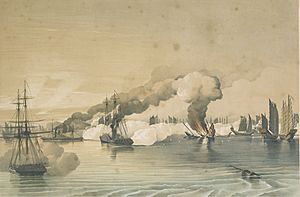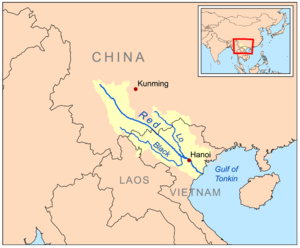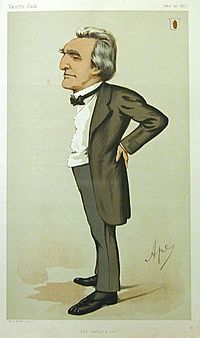Battle of Tonkin River facts for kids
Quick facts for kids Battle of Tonkin River |
|||||||
|---|---|---|---|---|---|---|---|
| Part of Piracy in Asia | |||||||
 Destruction of Shap Ng tsai's fleet |
|||||||
|
|||||||
| Belligerents | |||||||
| Commanders and leaders | |||||||
| Strength | |||||||
| Land: unknown land forces Sea: 2 sloops-of-war 1 brig 8 war-junks |
Land: ~1,400 pirates Sea: 64 war-junks |
||||||
| Casualties and losses | |||||||
| British: none 2 sloops-of-war damaged 1 brig damaged Chinese: unknown Vietnamese: unknown |
~2,400 killed or wounded ~300 captured 58 junks sunk |
||||||
The Battle of Tonkin River was a big naval battle. It happened in northern Vietnam in 1849. The fight was between pirates led by Shap Ng-tsai and the British Royal Navy. The British were helped by the Chinese navy and local Tonkinese forces. This battle destroyed Shap Ng-tsai's pirate fleet. Over 2,000 pirates were lost. The fighting lasted three days. It took place near Hai Phong, at the mouth of the Tonkin River.
Contents
Why Was Piracy a Problem in China?
Pirates in China's History
In 1810, the Qing dynasty government offered a pardon to all pirates in China. Thousands of pirates accepted this offer. They even joined the Qing navy. This helped reduce piracy in the Far East. However, many pirates still continued their activities. They operated along the southern Chinese coast.
Pirates used special ships called war-junks. Sometimes they used other boats too. Several pirate groups were active during this time. They often worked together in large groups. Their main target was merchant ships.
British Efforts Against Pirates
By 1847, the British Royal Navy started taking stronger action. They had already fought Chinese pirates since 1839. It took until the late 1860s to finally stop large pirate fleets. Even after that, some piracy continued in China. But new steam vessels changed how pirates operated.
Who Was Shap Ng-tsai?
Shap Ng-tsai was a powerful Chinese pirate leader. He attacked merchant ships in the mid-1800s. He commanded a fleet of about seventy junks. His base was near Tienpak.
The British commander, John Charles Dalrymple Hay, studied these pirate ships. He divided them into different types. At the Tonkin River, he saw sixty-four of them. The biggest junk had forty-two guns and 140 crew members. Sixteen other junks had twenty-eight to thirty-four guns. Each of these had about seventy-five men.
Smaller junks had twelve to nineteen guns and forty men. There were forty-two of these. The smallest junks had six guns and thirty pirates each. Most of the guns were 18-pounders. These were common for Chinese pirates. Commander Hay thought his ships faced 1,224 enemy guns. He also estimated there were 3,190 pirates. Shap Ng-tsai himself was on the largest junk, which was his main ship.
How Did the Expedition Start?
In spring 1849, Shap Ng-tsai sank an American ship. He also sank two British merchant ships. Because of this, the British sent a group of three ships. Their mission was to find and destroy the pirates.
The British ships were the brig HMS Columbine. There was also the sloop-of-war HMS Fury. The East India Company sloop HMS Phlegethon joined them. Each ship had twelve to eighteen guns. Their crews were around 100 men. Some Royal Marines also took part. They used boats and sailors from HMS Hastings.
Phlegethon was Commander Hay's main ship. It helped tow the Columbine in shallow water. The expedition left Hong Kong on October 8, 1849. Commander Hay sailed south along the Chinese coast. He searched many ports but found no pirates. He then went to Hoi-How. There, he met the local governor general. On October 13, the governor general ordered Admiral Wong to help. Wong commanded eight small Chinese junks. These junks joined Hay's expedition.
Searching for the Pirates
The fleet now had one brig, two sloops, and eight armed junks. They continued south to Chooshan. On October 16, they found the town burned. Many Chinese people were dead. The expedition learned that the pirates had left five days earlier. They had killed many men and taken several women.
From there, they went to Hoonong. On October 18, they saw a pirate lookout boat. Phlegethon chased it down. Men in its boats destroyed the pirate craft. On October 19, the expedition reached Hoonong. They found out the pirates were twelve miles away. They were near Chokeum in the Gulf of Tonkin.
On October 20, Hay arrived in the area. He decided to scout first with Phlegethon and some boats. During this, they saw thirty-seven pirate junks. They were sailing southwest towards the Tonkin River's mouth. Hay gathered his ships. The pirate junks searched for the river's opening for hours. When they found it, they entered. Hay then made plans to cross the sandbar.
The Battle Begins
October 20: First Attack
Hay's plan was simple: cross the sandbar and attack. Around 4:30 pm, the British and Chinese fleet entered the Tonkin River. Phlegethon went first, towing Columbine. Fury followed behind. The eight Qing navy junks came next.
Ten minutes later, at 4:40 pm, over thirty pirate ships opened fire. Their first shots mostly flew over the British and Qing ships. But as the expedition got closer, the pirates started hitting them. The British and Chinese ships began firing back accurately. Several pirate junks sank right away. Others caught fire and then sank.
After only twenty-five minutes, Shap Ng-tsai's main ship was hit many times. It exploded with a loud boom. Shap Ng-tsai survived, though. He moved to another, smaller junk. The battle on October 20 lasted until almost 8:00 pm. A total of twenty-seven pirate junks were sunk. Hundreds of pirates were killed. The Qing navy had some casualties. But the British had no one killed or wounded. When it got dark, the expedition stopped fighting. They dropped anchor and blocked the river.
October 21: Fighting Continues
The pirates had lost almost half their fleet. But Shap Ng-tsai decided to keep fighting. On October 21, the expedition attacked again. Some pirate junks were in very shallow water. Large warships could not chase them. So, several small boats were lowered. Each boat had one cannon. Sailors and marines manned these boats.
Under Lieutenant George Hancock and Captain Moore of the marines, these boats attacked. They fought the pirate junks up close. Nine junks were captured by the lieutenant's boats that day. Another fifteen were destroyed by other parts of the expedition.
After heavy losses, the pirates decided to flee further up the river. Two of their larger junks were ordered to go to Tonkin Bay. Their job was to fight off the British sloops. The remaining junks fled. Both of these pirate ships were boarded. Then they were sunk by gunfire. This fighting lasted an hour and twenty minutes.
During the three days of battle, over 1,400 pirates reached the small islands. They landed at the river's mouth when their junks sank. They had only muskets and matchlocks. They fought from the coasts, firing at the expedition forces. But then Tonkinese land forces attacked them. Several armed boats also joined the attack. At least 700 pirates were killed on land. About 300 were captured and given to the British.
October 22: The Final Push
On October 22, Commander Hay in the Phlegethon went to destroy the last pirate ships. Some boats went with him. That day, the Qing navy destroyed four junks. After joining Hay, they sank two more.
Shap Ng-tsai was clearly defeated. He took two smaller junks and four very small junks. With his remaining 400 men, he retreated further up the river. That was the end of the fighting. In total, fifty-eight junks were destroyed. An estimated 2,400 pirates were killed or wounded. About 300 were captured. Over 1,200 pirate guns were also taken.
A remarkable fact about the battle was that no one under Hay's command was killed or wounded. However, the Chinese and Vietnamese forces did suffer some losses. All the expedition ships were damaged in some way. At least three armed boats were hit by cannon fire.
What Happened After the Battle?
This battle was a big success. It helped greatly in the fight against Chinese pirates. Commander Hay and his men received awards for their actions. On January 20, 1850, Hay was promoted to captain. He later became an admiral. In the 1870s, he became a Privy Counsellor.
With his fleet destroyed, Shap Ng-tsai stopped being a pirate. He accepted a job as an officer in the Chinese navy. Later, he and Commander Hay fought against each other again. This happened during the Second Opium War from 1856 to 1860.
See also




